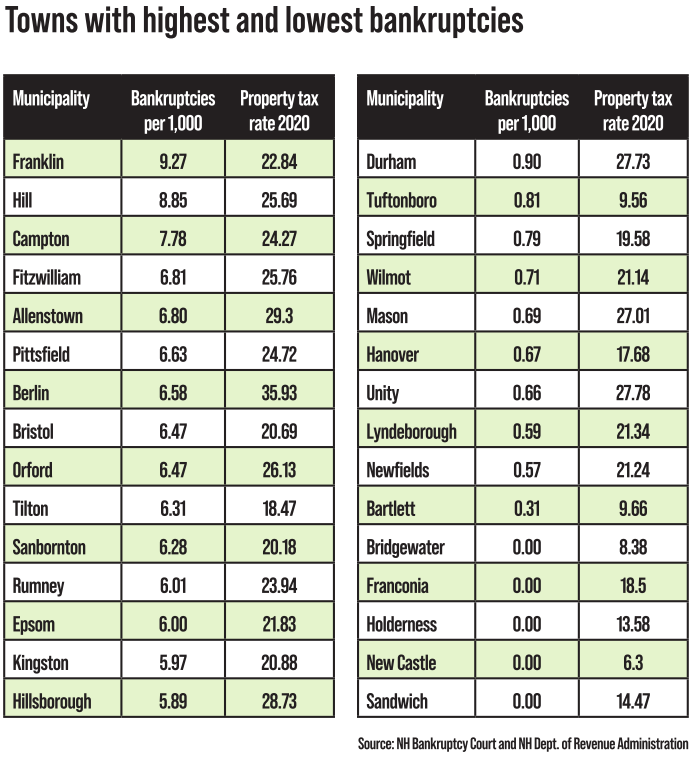Why do certain towns have high filing rates?

On April 26, Abigail Iris Small raised her right hand and swore to tell the truth, although the bankruptcy trustee couldn’t see her do it during the creditors meeting, because her bankruptcy hearing was being held over the phone. Still, he went ahead with the usual questions.
Have you ever owned any real estate?
No.
Did you list everything you owned on the schedules?
Yes.
Small couldn’t afford an attorney, so she filled those schedules out with the help of her mother, who is a paralegal — she couldn’t afford an attorney. They showed all of her assets: a 2006 Honda, family china from Poland, an old upright piano and two parakeets, totaling $36,458.31, far short of $64,634 she owed. The schedules also showed that her annual income from her job at Lowe’s — about the same as
her assets — could not support a family of five, even with monthly
child support payments and her husband’s disability income.
The
number of bankruptcies filed in New Hampshire have plummeted since the
pandemic to all-time lows. Still, on April 26, the bankruptcy trustee
held a total of 15 hearings. Nearly every case represented a life in
disarray. And in the last four years — from the start of 2018 to the end
of 2021 — there were more than 5,200 such cases filed in the Granite
State.
NH Business
Review downloaded through the U.S. Bankruptcy Court’s PACER system every
one of those cases, and — with help from Doug Hall, a member of the
board of the NH School Funding Fairness Project — analyzed the data to
get a better idea where the people who are filing live, what they are
filing and perhaps why they are filing — especially during the pandemic
economy, when the number of bankruptcies have plunged and employment has
skyrocketed.
Claremont suit towns
According
to the data, communities located in the area from the Capital Region to
just north of the Lakes Region have the most bankruptcy filings per
capita. Among municipalities with more than 5,000 residents, the city of
Franklin had the most per capita filings in the state — 9.27 per
100,000 people, more than 10 times the number of Hanover, which has the
fewest, at 0.67.
The
town of Hill, right next door to Franklin, is No. 2, with 8.85 filings
per 100,000 people. Other neighboring communities — Bristol, Tilton and
Sanbornton — all have rates above 6.0. Campton, 31 miles from Franklin
in the foothills of the White Mountains, has the third highest rate,
though Holderness, about 12 miles south of Campton, had none at all.
Two other towns not far from Franklin, Allenstown and Pittsfield also had high rates of filings: 6.8 and 6.6, respectively.
Franklin, Allenstown and
Pittsfield were three of the five plaintiff towns in the landmark
Claremont schoolfunding case, which resulted in the NH Supreme Court
ruling that says the state’s property tax-based school funding system is
unconstitutional.

Other municipalities with a
large number of filings were Berlin (6.58) and Derry (5.62). In terms
of the fewest, Hanover was followed by two other college towns, Durham
and Henniker.
Hollis, which has one of the highest median household incomes in the state, had the four fewest, with 1.44 filings per 100,000.
But
poverty alone doesn’t necessarily drive bankruptcies, since the
lowest-income people have little to lose and therefore less to protect.
Bankruptcy is a way to protect assets, so it is usually filed by people
with some of them, be it a car or house. It’s also for people who are
overextended on credit, which means they are able to obtain a credit
card.
Franklin
Mayor Jo Brown isn’t quite sure why bankruptcies are so high in
Franklin. She does have a theory, though. Homes in the city are selling
like hot cakes due to outside investors buying them up cheap, and she
suspects some people are using bankruptcy to get out of debt and unload
an underwater house, though if home prices are rising, it’s unclear why
that would be necessary.
‘The great reset’
The
common perception is that job loss explains bankruptcy, since
historically the two go hand in hand, but the pandemic economy with near
record-low unemployment has poked a hole in that theory.
Bankruptcies
fell across the board during the pandemic, but at different rates.
Business-related bankruptcies fell by about 25 percent between 2019 and
2021. Consumer-related bankruptcies fell by 60 percent.
Even greater was the drop in Chapter 13 filings, which are often triggered by homeowners trying to prevent foreclosure. They
fell by 78 percent. There were hardly any foreclosures in New Hampshire
during the pandemic, thanks to government regulation that at first
halted them, along with forbearance, loan modifications and outright
subsidies to help pay the mortgage.
“It’s
the great reset,” said William Gillen, a Manchester bankruptcy
attorney, who handled the second most filings in the four-year period.
“In my humble opinion, with all these trillions flooding the market,
there was no need to file bankruptcy. There was nothing pushing people
to file. People are in debt, but the creditors were not putting them in a
headlock.”
Bankruptcy
attorneys, who were all set for a deluge following the surge of
unemployment in the spring of 2020, suddenly risked going under
themselves.

Above:
Quentin Silveria, shown on the Harley-Davidson he used to own, filed
for bankruptcy after taking a different job during Covid.
At right: River Gogh Moon of Plymouth filed for bankruptcy as the result of a car wreck in Minnesota.
“It was terrible,” Gillen said. “I’m still profitable, and I have been a pretty good squirrel putting away my acorns.”
The
courts also shut down for a while, not only slowing the bankruptcy
process, but other courts that might push people into filing for
protection. That has created a huge backlog.
“I have a civil case
pre-Covid, and it was just getting scheduled for May,” said Concord
bankruptcy attorney Sandra Kuhn, who handled the most filings.
Both
Kuhn and Gillen said that filings have been picking up as of late. In
March they rose 53 percent from February, to 65. But that is still down
from March 2021 and prepandemic levels.
Even
before the pandemic, a 2019 national study revealed that the main
reason people file is not because they were laid off but because they
couldn’t pay their medical bills or health-related issues — either the
high cost of care or time out of work. Unaffordable mortgages or
foreclosures is the second most common reason, and living beyond one’s
means, usually via credit cards, is a close third.
Providing
help to friends and relatives, student loans and divorce were also
significant reasons in about a quarter of bankruptcy filings.
Using
2021 data to avoid the economic ups and downs of 2020, there doesn’t
seem to be any relationship between employment rates in a particular
town and the number of bankruptcy filings. But there does some seem to
be a correlation between a town’s 2020 household median income, the
percentage of residents on Medicaid and property tax rates. But such
trendline statistic correlations don’t necessarily work on an individual
town-by-town basis.
More than a quarter of Franklin’s population is on Medicaid, for instance, but Berlin is even higher (28.4). Claremont
had the second-highest Medicaid percentage, and the highest property
tax rate ($40.72), though it didn’t have that high a number of
bankruptcy filings, and Franklin’s $22.84 property tax rate was more at
the center of the pack.
‘The only person working’
Individual cases are even harder to decipher than numbers.
Small,
for instance, got into financial trouble in Concord in 2018, but ended
up filing while living in Laconia four years later.
She
kept her job, even during the year and a half she was homeless after
losing her apartment in 2018. She couldn’t support a family of five on a
retail salary following her new marriage and her third child. Her
husband, who had broken his back, was disabled, she said, so “I was the
only person working.”
Her
Concord landlord asked them to leave after they fell behind on their
rent (there were also ongoing issues about upkeep, she said), and they
weren’t able to find a place to live until February 2019, when they
found one in Laconia. When her mail finally caught up to her, she
couldn’t pay off all the accumulated interest on her debt. After one
creditor took her to court, she filed for bankruptcy on April 11.
Then
there’s one of attorney Kuhn’s clients, Quentin Silveria, a 25-year-old
of Franconia who filed when he lived in Littleton. He was working,
earning $65,000 in 2020 as a manager at Staples. He went out and
splurged, buying a Harley-Davidson Street Glide and a Chevy Silverado.
He
also took a trip to Kentucky. But the crazy Covid hours got to him, he
said, so he took a pay cut and become a 9-to-5 salesman elsewhere. With
the salary cut, he had trouble keeping up with the interest rates, and
ended up owing $107,500.
He traded in his motorcycle for a 2016 Subaru Impreza, which the Bankruptcy Court let him keep, but he had to give up the Chevy.
And
River Gogh Moon, who filed as Austin Maxwell, a 24-year-old student who
now lives in Plymouth, got into trouble in Minnesota when they drove
through a stop sign covered by a branch that wrecked their brand-new Kia
Rio. They couldn’t get insurance to pay, and eventually it was
repossessed, though there is still money owed on it.
Moon
also lost their job at a shoe store in the Mall of America but was able
to collect more than $12,000 in pandemic insurance in 2020. They ended
up going back to Tilton to live with their mother and getting a job at
Lowe’s. Moon’s filing last September showed $1,846 in monthly income,
$300 less than monthly expenses, with a little more than $400 in assets
and $21,000 in liabilities.
After a summer job at the Museum at the White Mountains, Moon is now a freshman at Plymouth State majoring in museum studies.
“I’m very happy about that,” Moon said.